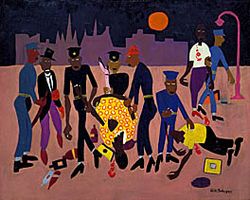Harlem riot of 1943 facts for kids
Quick facts for kids Harlem riot of 1943 |
|
|---|---|
| Date | August 1–2, 1943 |
| Location | |
| Caused by | Police Shooting |
| Casualties | |
| Death(s) | 6 |
| Arrested | 600 |
A race riot took place in Harlem, New York City, on August 1 and 2 of 1943, after a white police officer, James Collins, shot and wounded Robert Bandy, an African American soldier. The riot was chiefly directed by Black residents against white-owned property in Harlem. It was one of five riots in the nation that year related to Black and white tensions during World War II. The others took place in Detroit; Beaumont, Texas; Mobile, Alabama; and Los Angeles.
The riot ended on the night of August 2. Cleanup efforts started that day; the New York City Department of Sanitation worked to clean the area for three days and the New York City Departments of Buildings and Housing boarded windows. The city assigned a police escort for all department workers. The Red Cross gave Harlemites lemonade and crullers, and the mayor organized various hospitals to handle an influx of injured patients. By August 4, traffic had resumed through the borough, and taverns reopened the next day. La Guardia had food delivered to the residents of Harlem, and on August 6, food supplies returned to normal levels. Overall, six people died and nearly 700 were injured. Six hundred men and women were arrested in connection with the riot.
The underlying causes of the riot stemmed from resentment among Black residents of Harlem of the disparity between the vaunted values of American democracy and the social and economic conditions they were forced to live under. They resented the segregation of Black troops serving with the United States, and wartime shortages created more difficult conditions in Harlem housing and supplies. African-Americans suffered discriminatory practices in civil and private employment, and city services, which created tension as they tried to improve their lives. Bandy symbolized the Black soldiers who were segregated in the Army, even as the United States promoted the national fight for 'freedom.'
Cultural depictions

The riot became a subject of art and literature: it inspired the "theatrical climax" of Ralph Ellison's novel Invisible Man, winner of the 1953 National Book Award, it frames the events recounted in James Baldwin's memoirs Notes of a Native Son, and it appears in artist William Johnson's painting Moon Over Harlem.

